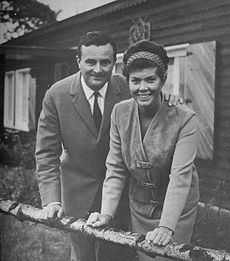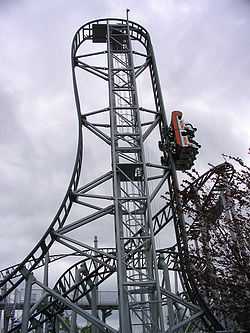Bobbejaanland



Bobbejaanland is a theme park in Lichtaart, Belgium. It was founded by Bobbejaan Schoepen, a Flemish singer, guitarist, and entertainer who enjoyed international popularity in the fifties and early sixties. After 15 years he got weary of touring. In 1960 he decided to build his own music theater: he started draining a 30 hectare marsh that he bought in 1959. He built a venue with 1000 places where he could perform as often as he liked. In December 1961, the Bobbejaanland amusement park was born. Bobbejaan and his family sold the park in 2004.
History
Bobbejaan's lifework grew organically from his musical career. His personal manager Jacques Kluger invented the name. For the first decade that it was open the heart of the park was a combination of water fun and show. Numerous artists from the Belgian, Dutch, and German variety scenes performed there. Following the advice of Phantasialand-owner Gottlieb Löffelhard, Bobbejaanland evolved from 1975 onwards in the direction of a regular theme park, with the music show gradually retreating to the background. Encompassing fifty attractions and four hundred employees, the park developed into a huge tourist draw in the Benelux countries, France, and Germany. Thanks to its independence as a family concern, it was also able to bridge the gap with educational and cultural projects. By the end of the seventies, Bob's wife José (a former opera singer and model) opened a museum with authentic works of art from the Hopi and Navajo cultures in Phoenix, Arizona, now one of the most complete private collections of Native American art in Europe.
From the beginning of the nineties, three of his five children participated full-time in the park. Now it can foster its reputation as a place that loves children and it can present itself as the first amusement park in the world that has focused on environmental policy. The most remarkable measure to that effect was the construction of a 70 meter high windmill that provides the whole region with energy, with an adjoining museum of alternative energy. With its mix of informative fun, Bobbejaanland can rank as a unique maverick among European amusement parks.
During the 43 years of the Schoepen-management the founding father was the artistic brain behind the park. His wife José (oldest of sixteen children) was the commercial backbone, and her sister Louise handled the accounting and finances.
Attractions


Bobbejaanland contains about 50 attractions, such as the Waterslide (1980), the Giant wheel (1976), Indiana River (indoor waterslide, 1991), the Revolution (a dark Rollercoaster, 1989), the Speedy Bob (roller coaster, 1998), the Air Race (suspended roller coaster, 1987, now named Dreamcatcher), the longest junior roller coaster in the world, 'Okidoki' (i.e. 'that's all right', 2003/04), and the world's second Gerstlauer Euro-Fighter roller coaster, "Typhoon" (2003/04), with a drop angle of over 97°(a roller coaster with a fourfold loop and a free fall) and a Splash Battle, "Banana Battle", (2007) made by Preston & Barbieri. The giant Sledgehammer (a Giant Frisbee) is a giant shuttle that reaches topspeeds of 110 km/h). In 'Kinderland' (i.e. Kids' Country, 1995) you'll find attractions for the smallest visitors on 7000 m2.
In 1979 Bobbejaanland opened the Looping Star roller coaster (Schwarzkopf GmbH), which became a ride with a certain cult status over the years. This was partially caused as not the small, unstable vertical bar over the hips prevented passengers to fall out during the looping, but the centrifugal force.[1] The coaster was dismantled in 2003.
Because Bobbejaan Schoepen was primarily a folk and country singer, the park is still partly themed as a western village (for example the El Rio White Water Rapids and the El Paso Dark Ride). In the Star Theater, Las Vegas style shows are performed. The life of Bobbejaan is also a lucky bag of colorful anecdotes. Once, he managed to buy the original Zorro's horse from guntumbler Casey Tibbs, but unfortunately the animal tread on an exposed cable and died. From his American friend Nudie Cohn, he acquired the peculiar white arty Pontiac car (Nudie Mobiles), skillfully decorated with American coins. He spent ten thousand dollars on it and used to drive it through the theme park. He would consider the car the most effective and talked-about element of all the attractions he featured.
Changes
In the winter of 2003, a major investment of 12 million dollars was made for a couple of world premières: the Typhoon and the Sledge Hammer (supra "attractions"). The consumer’s organisation Test-Aankoop conducted a survey of 13 European amusement parks. In Europe, Bobbejaanland came off second best after Phantasialand for being as good in every aspect under scrutiny, together with Disneyland and the Parc Astérix. For Belgium, Bobbejaanland is considered to be the best,[2] together with Walibi Belgium.
Bobbejaan Schoepen suffered from intestinal cancer, which gave rise to the idea to part with his life's work. In April 2004 the final decision to sell the park was taken, after a preparatory period of more than three years. Bobbejaanland was sold to the Spanish-American Parque Reunidos group and the last family concern in the sector of amusement parks in Belgium disappeared.
Since the park was sold in 2004, the number of visitors decreased significantly. In January 2007 the British company Candover bought Parques Reunidos for 935 million Euro from Advent (a financial group from Boston) who paid 3 years before 240 million Euro. Though the name Parques Reunidos still exists and operates 22 parks in 6 countries in Europe and in 2006 made a profit of 193.5 million euro.
Founder's later years
Bobbejaan focused again on his music career. In 2005 he gave four surprise performances on the European literary festival Saint Amour. On February 13, 2007, Bobbejaan Schoepen received in Belgium a Lifetime Achievement Award (ZAMU) for his important role in the Belgian music history. In April 2008, Bobbejaan released a new album called "Bobbejaan", featuring Geike Arnaert (Hooverphonic) and Daan Stuyven (Daan) produced by his own son Tom Schoepen.
Bobbejaan and his wife still lived until the founder's passing in May 2010 on the domain, in the original house where the history of the park began.
External links
- Bobbejaanland Website (English)
- Official site Bobbejaan Schoepen
- Official myspace Bobbejaan Schoepen
- The Yodeling Whistler
- Bobbejaanland Timeline
- Bobbejaanland Fansite (Dutch)
- Bobbejaan-Online (Dutch)
Sources
- Bobbejaan Schoepen (Johan Roggen, Publisher Het Volk, 1980 - D/1980/2345/10).
- De Vlaamse kleinkunstbeweging na de Tweede Wereldoorlog - Een historisch overzicht (Peter Notte, Universiteit Gent 1992). 'The Flemish Variety Movement after World War II - An Historical Overview'. Peter Notte, Ghent University, 1992)
- Bobbejaan Schoepen — "Histories" documentary, 4 January 2001 (Canvas/VRT)
- Bobbejaan Schoepen — The Belgian Pop & Rock Archive (Dirk Houbrechts and the Flanders Music Center, 2001).
- "Brel Le flamand" — Histories documentary, 2003 (Canvas/VRT).
- rides.nl
- Bobbejaan Schoepen Archive — Bobbejaan Records bvba
- Official Biography Bobbejaan Schoepen — by Tom Schoepen - "Volkskundige Kroniek" van de Federatie voor Volkskunde in Vlaanderen (i.e. “Folklife Chronicles”, magazine of the Folklife Federation Flanders)- yr. 14 - nr. 2 April-may-juin 2006).
- ↑ Looping Star Bobbejaanland
- ↑ Test-Aankoop magazine 477, June 2004
Coordinates: 51°12′04″N 4°54′18″E / 51.20111°N 4.90500°E